
Presentations In 2011
NOTE: Many of the following presentation summaries will include links to the Power Point slides used to illustrate the presentation.
Click HERE for instructions on how to control the slide show.
Click Top of Page above to return to 2011 index
Vol 88 No 14 - April 4, 2011
Protecting The Homeland: Protection of Citizenry, Infrastructure and Our Freedoms
Presented By: David Koltick, Director Applied Physics Laboratory, Professor of Physics, Purdue University
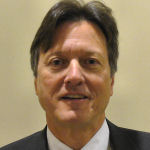
David Koltick
The Four Horsemen of the Apocalypse - Biological, Nuclear, Chemical, Explosives
Biological
Smallpox - Spain in South America
Salmonella Typhimurium Used by Indian cult on Public officials.
Anthrax
1979: The Sverdlovsk outbreak
2001 Washington DC via mail.
Biodefense - Biological Warfare (BW) Clouds
One way to detect these BW clouds is through the use of Doppler radar. Using reflected radio waves, a cloud and its shape can be detected.
Nuclear/Radiological
There are many countries/groups with existing and future desires for WMD.
The best defense is a good offense.
Chemical
Because of basically French testing of chemical weapons after WWII in North Africa, many major N. African nations are well stocked with chemical weapons.
There are many examples of chemical weapons being used by N, African/mid East armies in the 1960 -1980's.
Tokyo subway attack by extremists with Sarin-killed 12 and injured 5000 citizens.
One can simply go to the Internet to find out how to create chemical weapons.
Explosives
In the US the terrorist threat is probably from the use of fertilizer/fuel oil.
In the Mid East terrorists typically use plastic explosives in existing weapons, such as vests, car bombs, etc.
Three Prong Approach to Protection
Defense/Offense Efforts:
The Political and Financial Cost can be High
Intelligence Collection:
Limited by Intrusive nature
False Identification
Advanced Search Technology:
High Cost and Large Number of Sites Requiring Protection
Can Slow Commerce
Current Technology: X-ray and Mass Spectrometry
X-ray observes shape and density in container
Mass Spec detects trace quantities through wipe/puffer test
Proposed System: Combined X-ray Scanner and Neutron Interrogation System
Neutron interrogation yields the:
Elemental content of the sample.
Amount of each element within the sample.
Isotopic content of the sample.
Density of the sample.
These parameters can be measured:
Rapidly.
Without exposure to the sample.
Without reagents.
Regardless of the sample's container.
Non-intrusively.
Non-destructively.
This system can be used to scan mail, small closed containers, human bodies, luggage, automobiles, trucks, semi trailers, cargo containers, etc. An airport system for screening/scanning should cost about $200,000.
Click HERE to view the Power Point slides used in this talk.
Notes by J. L. Bettner
Vol 88 No 15 - April 11, 2011
The Remaking of the Grand Hotels in Springs Valley, IN
Presented By: Claude McNeal
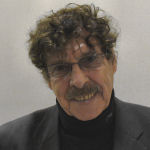
Claude McNeal
The speaker, a Professor of English, spoke on the early history of the French Lick and West Baden Resorts.
In 1778, George Rogers Clark discovered salt licks and mineral springs in southern Indiana. Initially, the government planned to mine the salt to satisfy demands for meat preservation, but later found insufficient salt content for large scale extraction. The land was sold to Dr. William Bowles who then built a small inn in 1832, at the present site of the French Lick Springs Hotel. When Dr. Bowles was called to serve during the Mexican-American War, he signed a five year lease with Dr. John Lane, expecting him to improve and enlarge the hotel. However, when he returned in two years, Dr. Lane then bought 770 acres from Dr. Bowles to build a bigger and finer hotel than the French Lick Springs Hotel. That started a fierce competition.
In 1852 Dr. Lane opened his new hotel named Mile Lick Inn which was renamed West Baden in 1855. In 1887 the Monon railroad built an extension to take guests to both the French Lick and West Baden Resorts. In the late 1800's, guests arrived from across the country on seven different railroads for relaxation and the curative powers of the mineral water. In 1888 Lee Sinclair bought off Lane's interest and turned the facility into a large resort. There was an opera house, a two-deck covered, one-third-mile oval bicycle and pony track. There also was a lighted baseball diamond in the center. These were all burned down in 1901. Sinclair had it rebuilt with the addition of a large dome and it was re-opened in 1902 and was called the Eighth Wonder of the World.
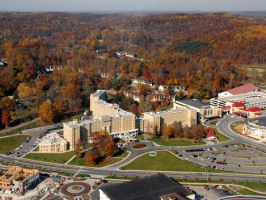
French Lick Hotel
After Sinclair died in 1916, his daughter Lillian and her husband took over. Another big fire destroyed the bowling alley and bottling plant in 1917.

West Baden Hotel
John Ballard, operator of illegal gambling businesses in the area, lent money for the improvement of the hotel which had served as an Army hospital during World War I. Lillian sold the property to Ballard for $1 Million in 1923. The market crash of 1929 also sent the two hotels into major downward spirals. In 1934 Ballard donated the property to the Jesuits, who turned it into a seminary. The seminary closed in 1964 and the Jesuits sold it to a company who then donated it to a private college.
After changing hands several times, Bill Cook, a local Bloomington billionaire entrepreneur and his wife, Gayle, initiated restoration activities in 1999.
Legislation in 2003 granted yet another gaming license.
Major restoration and renovation of the French Lick Springs Hotel Casino and renovation of the French Lick Springs Hotel occurred simultaneously in the fall of 2005. The hotel and Casino opened together on Nov.3, 2006.
Click HERE to view the Power Point slides used in this talk.
Notes by Gonz Chua
Webmaster's Note: The following excerpt from http://www.frenchlick.com/aboutUs/history/wbsh.jsp may help clarify the final restoration of these two grand hotels and particularly the role of Indiana Landmarks in the process: "Worried that the nationally significant landmark could not withstand another winter without investment in the building, HLFI West Baden, Inc., a subsidiary of Indiana Landmarks, bought the West Baden property for $250,000 in July 1996. An anonymous donor contributed the purchase price.
A corporate benefactor, Cook Group Incorporated of Bloomington, Indiana immediately began stabilization and partial restoration to make the property more attractive for redevelopment. Initially committed to spending $12-14 million on the property, Bill and Gayle Cook and their companies eventually tallied $30 million on the Phase I restoration (1996-early 1999), and an additional $5 million in maintenance (1999-2004). The exteriors of the hotel and all outbuildings were restored along with the garden. On the interior, the 100' x 200' domed atrium, lobby and flanking rooms, and dining room were returned to their original elegance.
After meeting with no success in its campaign to sell the half-restored West Baden Springs Hotel, Indiana Landmarks joined a lobbying effort to bring casino gaming to Orange County in order to save the National Historic Landmark (NHL) hotel and the nearby French Lick Springs Hotel, a landmark of the same era. Indiana Landmarks, Cook Group and Boykin Lodging (owner of French Lick Springs) joined with a group of citizen lobbyists who came to be known as "The Orange Shirts" for their t-shirts bearing the slogan "Save French Lick and West Baden Springs."
The multiyear lobbying effort succeeded when the Indiana legislature approved a casino in the 2003 session and a countywide referendum passed with ease that fall. The legislation created a joint preservation commission of the towns of French Lick and West Baden to oversee the historic hotels and casino district. A competitive process in 2004 resulted in the selection of Trump Hotels & Casinos as the operator of the new casino. However, the Trump firm's subsequent bankruptcy reorganization diminished its ability to meet the Indiana Gaming Commission's (IGC) requirements. In March 2005, the IGC reopened the bidding process for the French Lick/West Baden casino.
To ensure preservation of the two landmark hotels, Bill, Gayle and their son Carl Cook formed an entity called Blue Sky, LLC, in a bid for the casino license. Cook Group Inc. bought the French Lick Springs Hotel from Boykin in spring of 2005. A year later, Indiana Landmarks sold the West Baden Springs Hotel to Cook Group Inc. for a nominal sum in recognition of the vast investment the Cooks had made in its restoration. The Cook venture pledged to restore both hotels and build the casino and accompanying parking garage.
The Indiana Gaming Commission (IGC) selected Blue Sky as the casino operator in summer 2005. The French Lick Resort sought to "put heads in beds" on a year-round basis, thereby creating economic viability for the two historic hotels. The French Lick Springs Hotel closed just after Thanksgiving 2005 and was completely restored before opening with the new casino and conference center on November 3, 2006.
Restoration resumed at the West Baden Springs Hotel in the summer of 2006. When it reopened as a hotel in May 2007 for the first time since 1932, the hotel held approximately 240 rooms/suites, reduced from the original 508 small guestrooms (created in a time before queen-sized beds and television, when visitors spent little time in their rooms). The hotel's natatorium, long missing from the landscape, has been faithfully reconstructed based on historic photographs of the structure.
To ensure long-term protection for the West Baden Springs Hotel, Indiana Landmarks holds a perpetual preservation easement on the property. The easement requires Indiana Landmarks' approval for exterior changes to the hotel and its grounds and ensures that the site will be maintained no matter who may own it in the future."
Vol 88 No 16 - April 18, 2011
The Indiana Super Mileage Challenge
The Challenge is a competition for teams of high school students, who design and build cars to achieve the highest possible gasoline mileage. This year's Challenge was held at Lucas Oil Raceway west of Speedway.
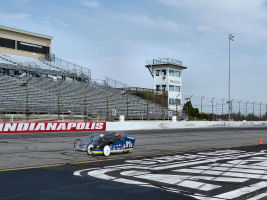
The Challenge is sponsored by the Indiana Mathematics, Science and Technology Education Alliance, as well as by the National Hot Rod Association , Briggs and Stratton, and Purdue, Vincennes and Ball State Universities. A similar program is starting in Illinois, and there is interest in several other Midwestern states and Tennessee, so the Challenge may spread widely.
High school students, and their faculty advisors, who want to compete start in the fall by submitting their plan for design and construction of a car, including mathematical analysis of their plan and the calculated performance of the planned vehicle. Basic safety equipment is required, of course.
The performance requirements are three or more wheels and a certain type 4-stroke Briggs and Stratton lawnmower-type engine (B & S supplies the engines free to the teams). In the Stock class, the engine must be as delivered; in the Unlimited class, it may be modified. The weight, length, width, height, aerodynamics, instruments if any, and the frame are up to the team. However, the driver must weigh at least 150 pounds; ballast may be used to make up the weight if necessary.
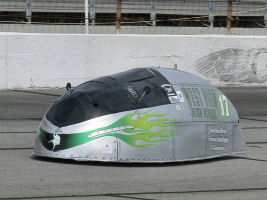
A typical car has a flat chassis, topped with a more or less aerodynamic bubble. The driver often lies nearly flat on the chassis, head to the rear, and has a steering wheel, brake and engine controls. Some cars run very small diameter wheels which are completely under the bubble; others use taller, narrow wheels outside the bubble.
Thirty-nine teams entered vehicles this year, two from Tennessee. Eighteen vehicles were in the Stock class, and 21 were Unlimited.
The Challenge was run on an 5/8-mile banked oval track. The course was 10 laps, to be run in no more than 25 minutes at an average speed of 15 mph. Each team could run as often as it wished. A car's fuel consumption for a run was determined by weighing its fuel tank before and after the run, and converted to mpg for the 6.25-mile run.
A team's final performance was determined by averaging the mpg figures from its best 3 runs.
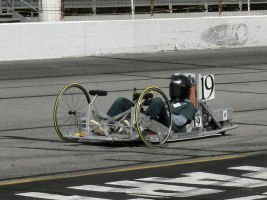
he driver's skill greatly influences the performance. It is usual to run the car up to a calculated speed and shut off the engine, coasting down to another calculated speed before starting the engine again. Those maneuvers, taking the wind into account, have a big effect on consumption. Vehicles coasting are required to stay on the left hand side of the track; vehicles accelerating are required to keep to the right side.
Many of the teams were very well equipped with umbrella tents, large tool-filled trailers and special-made workbenches to fit their cars. A few cars carried sponsors' names painted on the body.
The Unlimited Class Champion this year was Mater Dei High School from Evansville, IN with a mileage of 958.29 MPG. (Incidentally, Mater Dei of Evansville has won one or the other class every year since 2005.)
Click HERE to view additional pictures of the vehicles in today's competition.
Or click HERE to view still more pictures of the Challenge event, courtesy of John Morrical
Click HERE for a complete copy of the rules covering the design, construction, and competition
Notes by Joe Jones
Vol 88 No 17 - April 25, 2011
The Annis Water Resources Institute (AWRI) of Grand Valley State University. Its mission and relationship to the Scientific Club and its D.J. Angus Foundation
Presented By: Dr. Alan D. Steinman, PhD Director
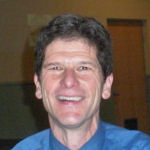
Dr. Alan Steinman
The Institute is named for an early and key member of Scientech, Robert B. Annis. Bob followed in the footsteps of his mentor and a Scientech founder, D.J. Angus. Both of these men spent summers in Michigan and became very interested in the preservation of the Great Lakes. They were both most important in establishing and funding the D.J. Angus Foundation. The Scientific Club through its foundation makes annual gifts to the AWRI. These gifts are used to fund scholarship assistance to summer scholars, undergraduate and graduate students as well as the Ron Ward scholarship. Preference is given in these awards to students from Indianapolis and then Indiana. Dr. Steinman applauded the quality of students from Indiana and thanked the Club and its foundation for the generous support.

Annis Water Resouces
Institute
The mission of the AWRI at Grand Valley is to integrate education, outreach and research to enhance and preserve freshwater resources. It is located in Muskegon, Michigan. To accomplish this mission there are many faculty, undergraduate and graduate students as well as postdoctoral fellows. The quality of the research of these individuals has been excellent resulting in numerous articles in peer reviewed journals as well as in the publication of technical manuals and reports. Extramural funding for the Institute now exceeds $2.5 million in new grants and contracts.
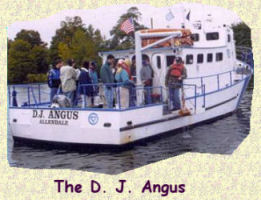
Understanding the water quality of our numerous lakes, rivers, and streams is critical to the sustainability of our entire region. Much of our social and economic well-being is related directly to high-quality beaches, water-related recreational opportunities, and safe and clean water resources. A Water Quality Index can be established to assign a score or grade to a lake or stream to express the overall condition of the water body and be useful to compare to other water bodies and to a given body over time. This has been a subject of research at the Institute. Another subject of research has been carbon cycling in Muskegon Lake. Freshwater ecosystems are highly reactive sites of carbon metabolism and the land- water -air link is a key component of the global carbon cycle.
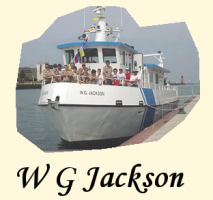
Clean fresh water is a shrinking resource and has become a limiting commodity in large parts of the globe. Overuse, pollution, and contamination in developing countries have contributed to this dire issue. The BioSand filter is an inexpensive remedy as it delivers
purified potable water at the point of use. Research into the physical, chemical, and biological functions of these filters has been very limited. Enhancing the knowledge of these functions is being accomplished by graduate students at the AWRI.
During the past two centuries invasive species have significantly changed the Great Lakes ecosystem. An invasive species is a plant or animal that is non-native or alien to ecosystem. At least 25 non-native species of fish have entered the Great Lakes since the 1800s. These include the round goby, Eurasian ruffe, sea lamprey, alewife and Asian carp among others. These fish compete for food and habitat increasing degradation of wetlands resulting in loss of plant cover and diversity. Non-native mussels and mollusks inadvertently introduced have also caused turmoil in the food chain.
The Great Lakes have also been troubled by invasive plants such as the common reed, canary grass etc. These plants can grow very rapidly and displace native plants affecting wildlife habitat, soil erosion and recreation such as swimming and boating.
Two lake going research vessels are in active use at the AWRI , one the W. G. Jackson and the other the D.J. Angus. These vessels are also used for the annual summer boat trip attended by several club members who assist the instructors and serve as chaperones for the award-winning Indianapolis and vicinity high school students.
Click HERE to view the Power Point slides used in this talk.
Notes by Jerry Kurlander
Dr. Steinman has also provided an update on the Annis Water Resources Institute and the current Great Lakes challenges. Click HERE to view this update.
Vol 88 No 18 - May 2, 2011
Analyzing Disaster - The BP Oil Spill
Presented By: Steven T. Wereley, Ph. D.
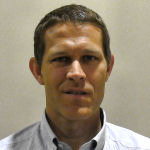
Steve Wereley
Dr. Wereley has a B.S. in Physics and in Mechanical Engineering. He went on to earn a Master's Degree and a Ph.D. at Northwestern University, both in Mechanical Engineering. He is a Professor of ME at Purdue University. He has written two books, one of which is entitled "Particle Image Velocimetry." That is the subject of today's talk.
We all remember the Gulf oil spill on 20 April 2010. Dr. Wereley was consulted on that issue because of his work on the flow of fluid around an object at very small scales. An example is the flow of liquid around a Red Blood Cell, which measures 5-8 microns wide. A human hair is 80 microns wide. He measures velocity by using particle images, mostly in micro systems. Dr. Wereley and three German Professors wrote the second edition to the book on Velocimetry.
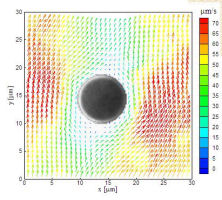
Blood Cell Flow
The semi-submersible drilling platform, owned by British Petroleum, in the Gulf of Mexico is actually a ship that can turn as necessary to hold its exact position. The well pipe from the vessel went through one mile of water and two miles of rock to reach the oil formation. On that April day, BP was just ready to close that well and prepare it for pumping oil out of the well. Up to that day, no oil had been recovered from that site on the sea bed. At that point, there was a blow out from the well which took the lives of eleven people on the vessel and caused a 36-hour fire; the vessel then sank.
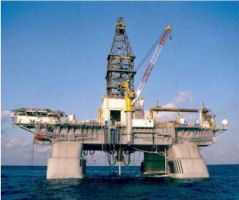
Deep Horizon Vessel
In the early days of the oil industry, a spectacular eruption of gas and oil ofter resulted when the drill stem reached the oil formation which was under high pressure. Today, for both economical and environmental reasons, oil companies circulate heavy drilling "mud" through the well to hold back the pressure and use a blow out preventer on the well head to prevent the oil from erupting. The oil at the bottom of the BP well is under a pressure of 11,000 psi and, in this event, the blow out preventer failed to stop the oil from erupting.
Scientists were not sure of the extent of the problem until late May, 2010. Little oil had reached the shore, and much of it never did reach the beaches. A video released by BP showed the oil rising from the pipe at the sea bed. BP later estimated that 5,000 barrels per day were being released.
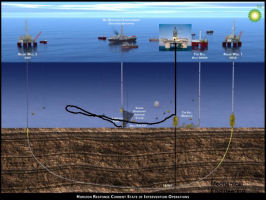
Intervention Operations
On 13 May, National Public Radio sent Dr. Wereley an email asking whether he could calculate the flow of oil from the well.The basic questions concerning the extent of a spill are how fast is the oil moving and how large is the opening. NPR sent the BP video to Dr. Wereley. Although it was short and of poor quality, it was possible to estimate the oil velocity by analyzing the video frame by frame.
By a series of computer analyses, Professor Wereley estimated that the loss of oil was 70,000 barrels a day, plus or minus 20%, not 5,000 as BP had announced (an oil barrel is equivalent to 42 gallons). Soon after this information went public, Steve Wereley from West Lafayette, IN found himself featured on 1,200 media outlets. The questions and interviews continued all summer long. Two other scientists estimated the loss of oil in the range of 20-100,000 barrels a day. Essentially, they agreed with Dr. Wereley.
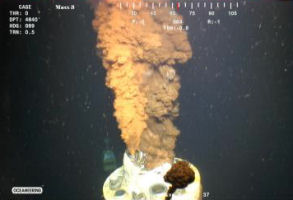
Improved Video
This oil spill dwarfs the Exxon Valdez disaster. In the Exxon case, the oil spilled from a tanker, with a known quantity of oil. When the Gulf of Mexico well was finally capped on 14 July 2010, 4.9 million barrels or 200 million gallons had escaped. The oil lost was 19 times that of the Alaska spill. Dr. Wereley reported his findings to a Congressional Hearing in Washington, D.C. on 19 May 2010.
It is still unknown why the blow-off preventer didn't work. Thankfully, BP was finally able to cap off the well after 54 days. Dr. Wereley is not an ecologist but he stated that the full impact of the oil spill on marine life is still being studied.
Click HERE to view the Power Point slides used in this talk.
Notes by Bill Dick
Vol 88 No 19 - May 9, 2011
The Fall Creek/White River Tunnel Vision for Capturing Combined Sewer Overflow (CSO)
Presented By: John Trypus, Project Manager, Black & Veatch Corporation
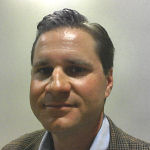
John Trypus
Our presenter today was John Trypus, Project Manager, Black & Veatch. John has a BS from the University of South Florida and an MBA from Johns Hopkins and is a PE and registered Professional Geologist. Black & Veatch is a consultant to the City of Indianapolis on this major sewer overflow project. John normally gives this presentation with John Morgan, Indianapolis DPW.
The Tunnel Project is one part of a $3B multi-year project to capture CSO (Combined Sewer -sanitary and storm- Overflow). Indianapolis agreed to build this system in a consent decree with the EPA because of untreated sewage overflows during rain storms which contaminate both waterways and groundwater (which supplies 20% of Indy's potable water). The project is currently in the design phase with construction planned for 2014 to 2024.
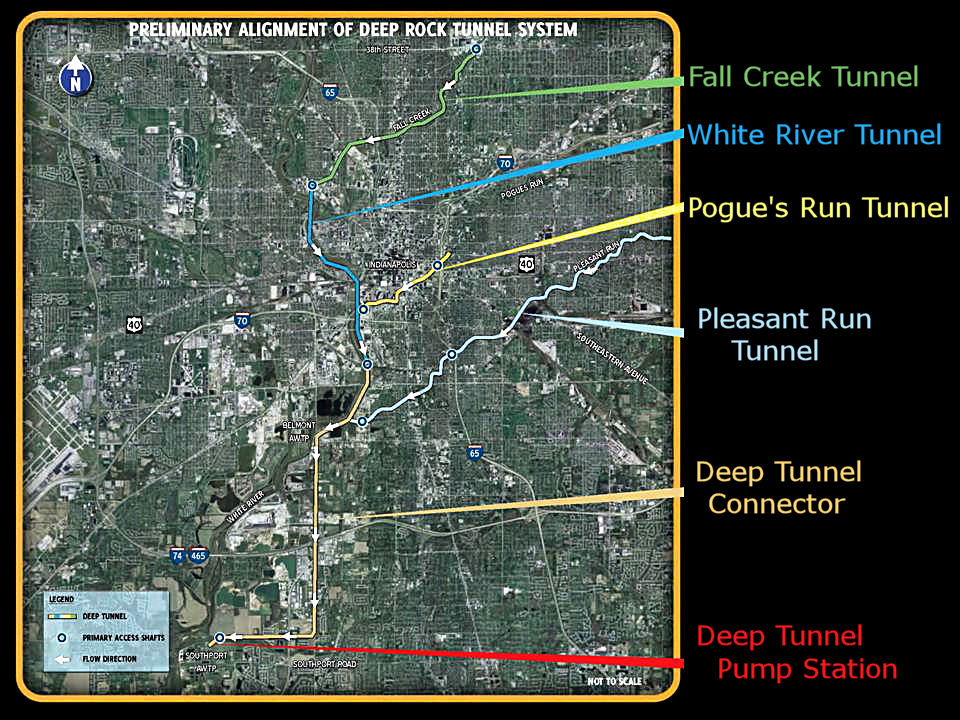
The Long Term Control Plan is to build tunnels essentially beneath the five main waterways (White River, Fall Creek, Pogues Run, Pleasant Run, and Eagle Creek) that will capture and store sewage and storm water during wet weather. The 250 M gallon capacity will be then pumped out and treated over three days at the Southport and Belmont Advanced Water Treating Plants (AWTPs) to be ready for the next storm. Overflows occur 45-80 times/yr. With this added storage capacity the overflows will be reduced to 3-4/yr and will be smaller. As a perspective, the largest surface quarry (Harding St.) could hold only 5-6 M gal. There are 140 points where overflows occur. All will be addressed. As part of the plan both AWTPs will double capacity from ~150M gal/day to 300.
The centerpiece of this program is the Fall Creek / White River Tunnel System. In the current design phase, over 150 bore holes have been drilled to assess 1) physical soil and rock characteristics, 2) soil and groundwater environmental screening, and 3) hydraulic packer testing of the bedrock permeability. Besides finalizing the design, these data will help define the exact route of the tunnels. The bore holes are key tools, but as John quipped, the actual tunneling will be "The Final Frontier".
The main tunnel will be 18' in diameter and a connector tunnel will be 12' dia. for a total of 11 miles. Both will be 250-270 ft below ground through the limestone bedrock. Initially the plan was to be closer to the surface, but staying in bedrock has advantages of less infiltration (groundwater filling the tunnel) and stability (below fracture zones) as well as lower total cost. The limestone is ideal for tunneling. The tunnel will be drilled by a Tunnel Boring Machine with diamond-tipped cutting heads. The initial diameter will be 20'. The tunnel will be lined with cement to a finished diameter of 18'. From the start of the tunnel near the fair grounds to the Southport AWTP, the tunnel will drop 60 ft. Earthquake risk is not high in Indiana, but the risk down in the bedrock is even less as most movement is at the surface.
Overflows will drain from the surface to the tunnel through 39 vertical "Drop Shafts" near the current CSO's. They will be designed for a vortex water flow (as water drains in a toilet) to reduce pressure of the falling water on the tunnel itself.
Today the city announced bids will be solicited on May 16.
Click HERE to view the Power Point slides used in this talk.
Notes by John Peer
Vol 88 No 20 - May 16, 2011
Antarctic Glacial and Geological History
Presented By: Dr. Kathy Licht, Assoc. Prof. Earth Sciences, IUPUI
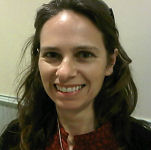
Dr. Kathy Licht
Dr. Kathy Licht received her Ph.D. from the University of Colorado, Boulder, in 1999. She is an associate professor in the Department of Earth Sciences at IUPUI. The Department of Earth Sciences was started as the Geology Department in 1967 by Dr. Arthur Mirsky.
Dr. Licht's research in the Antarctic was sponsored by the National Science Foundation. She has been the Principal Scientist on several research projects in the Antarctic. The purpose of the research projects was to determine what rock formations exist under the ice sheets and what the ice sheets looked like in the past.
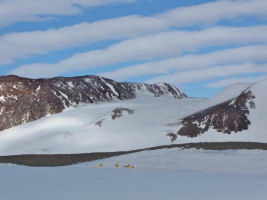
Antarctic Glacial Camp
The average thickness of the Antarctic ice sheets is about a mile. All of the ice sheet moves, the fastest glaciers move 500 meters per year.
Most of the Antarctic would qualify as a desert as less than 254 mm of water, in the form of snow, falls in a year. Antarctica is larger than the U.S. In winter, the temperature has reached -128 degrees F.
To determine what rock formations are under the ice sheets, Dr. Licht retrieves sand that the glaciers have scraped from the rock formations. To a geologist sand is any grain from 1/16 mm to 2mm. The shape, composition and age of sand are a capsule of Earth history.
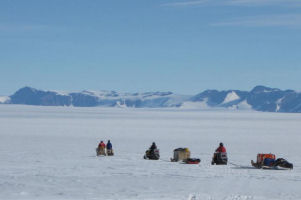
Antarctic Sledge Party
Sand can go through erosion, transport, deposition, erosion, transport, deposition, burial, lithification, uplift, erosion again and again. In the Antarctic, sand is found where the ice sheets ran into mountain ranges or in moraines left by glaciers. Nunatak sites are where a mountain peak barely rises above the ice. Sand that has been carried by the glacier is found there.
In using sand to determine the geology of the Antarctic, it is necessary to know the direction of the ice flow to determine where the sand came from. The grains of sand can be identified in thin sections.
If the sand contains zircons, which contain uranium 238, the age of the sand can be determined by determining the ratio of the uranium 238 isotope to the lead 206 isotope. U238 has a half- life of 4.5 billion years and decays into Pb206.
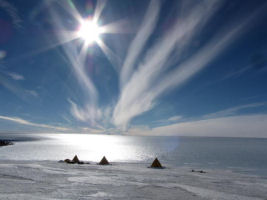
Antarctic Sky
Dr. Licht and her team discovered sand at the Lonewolf Nuntaks showing the expected quartz, feldspar and mafic igneous rock material. However, evidence of unexpected felsic, igneous, and metamorphic rock was also discovered.
Evidence of active volcanoes below the ice sheet was discovered. They also found a meteorite.
The research established that sand composition can reveal buried rock types and zircons can establish the age of buried rock types. Sand composition and zircons can be traced onshore to offshore as an ice flow tracer.
Goals of this past season are to determine if the sand composition changes over time, to estimate the age of moraines and to constrain ice thickness over those time scales.
Dr. Licht also described the facilities at McMurdo Sound and in the field. The airplane transportation to the sites where the sand and rocks were collected was not for the faint hearted.
Click HERE to view the Power Point slides used in this talk.
Notes by Malcolm Mallette
Vol 88 No 21 - May 23, 2011
Window to the Past: Nile Valley's Ancient Civilizations Share Valuable Lessons
Presented By: Michele T Buzon, Associate Professor
Department of Anthropology, Purdue University
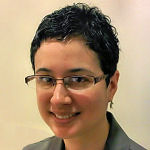
Dr. Michelle Buzon
Dr Buzon, a bioarcheologist, shared her research in the Northern Sudan comparing the Ancient Egyptian and Ancient Nubian cultures. She explained what she did was study the bones excavated in and around the city of Tombos. Reading what is in the bones of ancient human skeletons such as wear on joints, artifacts left by disease, injuries, and measurements can permit her to determine what type of lives these people led; their state of nutrition, type of work they preformed, age, and any interpersonal violence they experienced.
There were two main ages of interest, the Ancient Egyptian, the New Kingdom, 1550 to 1050 BC and the Napatan, a later time period, from 700 to 300 BC. In the Ancient Egyptian period the Egyptians expanded their rule and colonized Nubia. The Napatan period coincided with the decline of Egyptian power and the Nubians succeeded in ruling Egypt, the age of Black Pharos. The Nubians became egyptianised taking on the culture and religion of the Egyptians.
By careful excavation, noting the type of tombs, articles buried with the person, position of the body, their clothing, and jewelry it is possible to determine if the skeleton is Egyptian or Nubian. As the interaction between cultures continued both groups adopted part of the others culture and a mix of findings resulted to form a hybrid culture.
Bioarcheology attempts to reconstruct the past from human skeletal remains; who a person was in the past, who were their ancestors, how old were they, what sex were they, were they healthy, what was their occupation, and how they interacted in their society.
Biological features aid in separating out the hybrid culture; skull measurements were different in the North from those in the South. Not much Nubian art is available until we get to the Christian period. So then we get a good picture of how they looked.
Oxygen and strontium isotope analysis of bone makes it possible to determine where the people originated. Oxygen is associated with elevation, rainfall, and latitude. Strontium is associated with the age and composition of rock. These finding resulted in determination of a mix of local people and foreigners.
Bone studies indicate which diseases were present by the type of lesions discovered and the level of nutrition as well.
Dental disease is another indicator of health and nutritional status. Dental wear indicates type of diet and can give a history of disease.
Traumatic injuries indicate the presence of interpersonal violence. Low levels indicate periods of peaceful coexistence. Accidents are determined from bone injuries. Osteoarthritis indicates who worked in physically demanding jobs. Muscle insertion points give us a clue as to level of physical exertion required. In Tombos there is less osteoarthritis and it is therefore believed that the people here were more administrative than workers.
Anthropology attempts to bring it all together; the arts, science, medicine, and sociology.
Notes by Charles Hamm
Vol 88 No 22 - June 6, 2011
The Physics of Sailing and the Experience of Crossing the Atlantic Ocean in a Five-Masted, Square-rigged Ship...Twice!
Presented By: Bonnie Carter
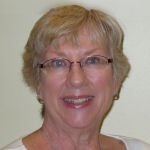
Bonnie Carter
Bonnie Carter made an excellent PowerPoint presentation. Unfortunately, the K of C projection system chose this day to emulate the wreck of the Edmund Fitzgerald.
Bonnie first sailed on a Sunfish, a small, single-sail boat with a dagger board instead of a keel. The Sunfish was able to sail toward the wind based on the same principles of physics that apply to all sailboats. While a sailboat cannot sail direct into the wind, racing sailboats can sail to within 30 degrees of the wind and other sailboats to within 40 or 45 degrees of the wind.
Going directly away from the wind, the wind pushes on the sail and moves the sailboat. Going toward the wind, the sails exploit Bernoulli's theorem. The sail forms a shape similar to the top of an airplane wing. The air passing on the outside of the sail has to go farther to pass the sail than the air passing on the inside of the sail. The higher velocity air on the outside forms lower pressure and creates forward suction.
There is much discussion of whether Bernoulli's theorem is the only factor. Re-direction of the velocity of the air flow, a vector, may also create a forward force vector.
A sailboat has a driving force, caused by the wind flowing across the sail. A sideways force is generated by the wind. The keel prevents the boat from moving sideways. There is a heeling force which causes the boat to heel or tip to the side away from the wind. The heeling force is resisted by the keel and the weight of the load.
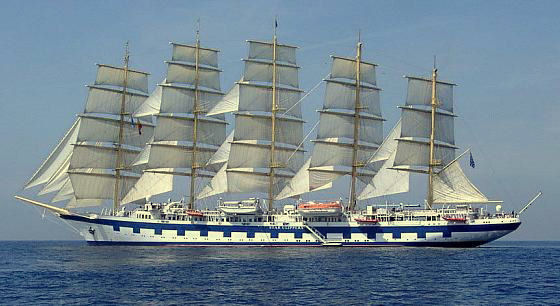
Royal Clipper
Bonnie met sailing friend Barbara on a cruise in the Society Islands. To celebrate Bonnie reaching age 50, they went on a transatlantic voyage on the 439-foot Royal Clipper, a 5-masted full-rigged ship, the largest sailing ship in the world. It is the third luxury passenger sailing ship of the Star Clipper Company.
They visited Madrid and Malaga prior to setting sail from Spain. The first port of call was Casablanca, Morocco. There they learned the three rules of bargaining in a souq, never bargain for something you do not want, don't hurry, and praise the shopkeeper for his hard bargaining.
The next stop was the Canary Islands, where Columbus provisioned his 3 ships before sailing west. Those famous ships had lengths about the same as the Royal Clipper's width. The Royal Clipper is a luxury ship, complete with a spa.
The ship's modern navigation equipment is a great advantage. In the time of Columbus, maps were precious, were rarely accurate and explorers would make up tall tales about the places they claimed to have discovered.
Bonnie advises amateur crews and guests: Never go on a yacht except with soft rubber-soled shoes; never talk to the man at the wheel, particularly if racing; don't make a habit of continual swearing, reserve it for special occasions. Finally, don't always want to go ashore, you are there for a yachting cruise.
One additional point. The bowsprit is actually a mast to which jibs and stay sails are attached. Under the bowsprit is usually a figure head, usually of a beautiful woman. If the figure head is a skeleton, as in the latest Pirates of the Caribbean, do not go.
Bonnie made a second transatlantic crossing, this time with her husband Jim. The figure head was of the daughter of the line's CEO.
Unfortunately, projection problems prevented the display of the Power Point slides intended for this talk. Click HERE to view the Power Point slides which were meant to have been used.
Notes by Malcolm Mallette
Vol 88 No 23 - June 13, 2011
Some Solutions to Life and the Universe: Observations from sciencedaily.com
Presented By: Dr. Alan D. Schmidt
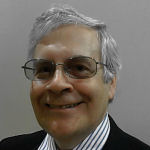
Dr. Alan Schmidt
Dr. Schmidt is an Environmental Engineer at the Indiana Department of Environmental Management. He earned his PhD in Chemical Engineering from the University of Wisconsin at Madison. In addition to being a Scientech member, he is also a Mensa member.
Alan's summary: "Be amazed by recent research article highlights from www.sciencedaily.com in areas of health, the universe, and more. Brief highlights are provided on genetic survival of the kindest, cancer, aging, disease, Alzheimer's, chemical benefits, and higher IQ with exercise, brain wave writing, black holes creating galaxies, exoplanet atmospheres, and more."
A few samples from the many Alan covered:
New Research Rejects 80-Year Theory of 'Primordial Soup' as the Origin of Life, ScienceDaily (Feb. 3, 2010) - For 80 years it has been accepted that early life began in a 'primordial soup' of organic molecules before evolving out of the oceans millions of years later. Today the 'soup' theory has been over turned in a pioneering paper in BioEssays which claims it was the Earth's chemical energy, from hydrothermal vents on the ocean floor, which kick-started early life.
Social Scientists Build Case for 'Survival of the Kindest', ScienceDaily (Dec. 9, 2009) - Researchers at the University of California, Berkeley, are challenging long-held beliefs that human beings are wired to be selfish. In a wide range of studies, social scientists are amassing a growing body of evidence to show we are evolving to become more compassionate and collaborative in our quest to survive and thrive.
And some of the titles only:
Evolution Caught in the Act: Scientists Measure How Quickly Genomes Change, ScienceDaily (Jan. 3, 2010)
Food Combination Associated With Reduced Alzheimer's Disease Risk Identified in New Study, ScienceDaily (Apr. 13, 2010)
Obesity, Weight Gain in Middle Age Associated With Increased Risk of Diabetes Among Older Adults, ScienceDaily (June 24, 2010)
Young Adults Who Exercise Get Higher IQ Scores, ScienceDaily (Dec. 3, 2009)
New Method Targets Cancerous Tumors Without Harming Healthy Cells, ScienceDaily (Nov. 2, 2009)
Black Hole Caught Zapping Galaxy Into Existence?, ScienceDaily (Nov. 30, 2009)
Algae Turned Into High-Temperature Hydrogen Source, ScienceDaily (Nov. 16, 2009)
Alan's message was that knowledge is expanding exponentially, and the (free) Science Daily website offers convenient one page summaries on this cutting edge research that give insight into many issues in our daily lives. The site is well organized by topic.
Links to many of the interesting items published in the Science Daily may be accessed at:
https://docs.google.com/document/d/1FTxa8N2mWRq4RUBZXaA82lOiODzjVoyN-4qaeMShez8/edit?hl=en_US&authkey=CNi5ylk
Notes by John Peer
Vol 88 No 24 - June 20, 2011
Transformation of the Library in the Information Age
Presented By: Lewis Miller, Dean of Libraries, Butler University Libraries
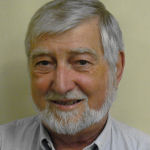
Lewis Miller
Mr. Miller started by stating that libraries are about preserving the records of humankind and making them accessible to everyone. They are about supporting learning and scholarships. Mr. Miller started by stating that libraries are about preserving the records of humankind and making them accessible to everyone. They are about supporting learning and scholarships. This includes printed books, manuscript or digital files.
With electronic search engines like Google, Google Scholar, PubMed and others, there is such an information overload that libraries and librarians are much needed to help people access and properly interpret the massive amount of information available.
Founded in 283 BCE, the Royal Library of Alexandria was the largest library in the ancient world. It had as many as 199 resident scholars conducting research in all subjects. It stored 400,000-700,000 parchment scrolls from many nations. Small libraries also existed in other parts of the world. Ancient monasteries also were centers for the copying and storing of manuscripts.
With the invention of movable type, books could be more easily printed and libraries became more common in societies and educational institutions.
By the 19th century, free public libraries became the dominant model in the United States. The influx of large number of immigrants influenced the growth of public libraries. They became the primary vehicle for immigrant assimilation. The development of the Dewy Decimal System, allowed for a simple, coherent and flexible filing system.

Butler University Library
The library's roles are: preservation of information; organization and management of information; and providing access and helping people with the information. Other activities include educational support for immigrants, teaching, and supporting scholarships and research. It is also a public space for people to spend time.
Websites of interest:
1. Indiana Virtual Library-Inspire
2. Business Source--Precision
3. Corporate Business Net
4. Small Business Resource Center
5. Ball State University, Purdue University, and Butler University Libraries.
Click HERE to view the Power Point slides used in this talk.
Notes by Gonz Chua
Vol 88 No 25 - June 27, 2011
Advances in BioCrossroads
Presented By: David Johnson, President & CEO, BioCrossroads
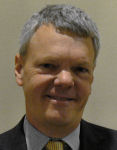
David Johnson
"Though every state wants to be a hub for Life Sciences, Indiana really is one….Life Sciences accounted for 23% of all Indiana job growth from 2001 to 2007." The Economist, June 4, 2009.
At the turn of the century, a group of city leaders were pondering the future of central Indiana, and how the area could capitalize on opportunities for the new century. The Central Indiana Corporate Partnership, with key support from the Lilly Endowment, retained a nationally known consulting firm to identify, quantify, and analyze growth engines for the region. One area-Life Sciences-stood out as a sector of unusual richness, with strong players such as Eli Lilly, Dow AgoSciences, Roche Diagnostics, Cook Group, IU School of Medicine, IU and Purdue Universities, and with robust chances for success. What was needed, however, was an enterprise that would connect these major, global life science leaders to one another and focus them on working together to create the next generation of regional research strengths and commercial success. BioCrossroads was the result.
WHAT IS BIOCROSSROADS?
WE INVEST
Indiana Future Fund - $73 Million for early-stage life sciences investments
INext Fund - $58 Million for Indiana Future Fund
Indiana Seed Fund 1 - Pre Venture Fund
Indiana Enterprise Fund - $3 million
WE CONNECT
We connect by creating and branding new and financially self sustaining Life Science enterprises.
Indiana Health and Information Exchange - IHIE
Fairbanks Institute for Healthy Communities
BioCrosswords - LINX
WE EDUCATE
We Spread the word by building awareness in marketing Indiana's Life Science Industry.
Talent Recruitment and retention
Training and Workforce Development
Improving K-12 Science and Math
In Warsaw, IN, a community of 18,000 residents, 7000 people are employed in the Life Science field. 33% of the global orthopedics industry is centered in Warsaw.
In times of an economic decline the Indiana Life Science industry has enjoyed a 21% increase in employment. Wages have increased:
For most Hoosier workers--$40K
For Life Science workers-$80K
Indiana is the 3rd largest exporter of pharmaceuticals. The economic impact has been over $44Billion.
In the last five years over 1900 patents in the Life Sciences have been awarded.
WE DELIVER
Raised one-quarter Billion dollars of market capital and philanthropic funding to identify/pursue new Indiana Life Science opportunities.
Organized two Life Science venture capital funds - The Indiana Future Fund and the Inext Fund.
Organized the Seed Fund and the Indiana Enterprise Fund.
Brought venture capital from these four funds to 24 start-up Indiana companies.
Attracted over $160 million of additional outside venture capital.
Formed 8 new sustainable enterprises to advance Indiana Life Science strengths.
Assisted in the attraction of over 3000 new jobs in existing Life Science Companies.
Elevated Indiana's visibility on the national map of biotechnology, medical, device and healthcare IT facilities.
Click HERE to view the Power Point slides used in this talk.
Notes by Jim Bettner